If you are among the many Australians who have contracted COVID-19, you might be grappling with a range of mixed emotions.
On top of worrying about the immediate health risks, you might be feeling fear of having passed it onto others, regret about your movements, or even shame at having caught the dreaded virus.
According to Dr Clare Southerton, a sociologist and postdoctoral research fellow at UNSW Sydney, it’s important that people try not blame themselves during the difficult period.
“The most important thing to remember is that a pandemic isn’t an individual responsibility or event,” she says. “It’s a societal event that we’re all going through.
“No one is individually responsible for COVID-19, even if we all have to take responsibility.”
Dr Southerton says some people might be tempted to play the ‘what-if’ game, and spend time thinking about how they could have done things differently – or the worst-case scenario of how things might pan out.
Examples include:
- What if I went grocery shopping two hours earlier?
- What if I didn’t fill up petrol that day?
- What if I passed it on to others?
However, these thought loops – which are easy to get stuck in – aren’t helpful, she says.
“A lot of people catch the virus after doing nothing wrong,” says Dr Southerton, who researches the intersections between sociology, health and social media at UNSW’s Vitalities Lab, Centre for Social Research in Health, and Social Policy Research Centre.
“So remind yourself that this is something largely out of our control, and be kind to yourself in this really difficult time.”
But why do we often judge ourselves harshly for catching COVID-19 – and where does this feeling of shame come from?
COVID shaming in Australia
Up until recently, you wouldn’t have been alone if you felt relatively safe from the virus in Australia.
When compared to many other countries, daily case numbers have been seemingly low since the start of the pandemic – even if they are on the rise is some states now.
But a side effect of lasting so long with relatively few cases is that positive cases are often pulled into the media spotlight.
“When there are relatively low cases, public attention is focused on people who have contracted the virus,” says Dr Southerton.
“This can really heighten stigma and shame.”
She says in countries like the United States, media attention and public anger has mostly been aimed at superspreader events. But in Australia, this negative attention has largely been targeted at people simply going about their daily lives.
Not long ago, it was common to see Australian media outlets describe in detail the activities of someone who was a positive case, such as visiting barbeque stores or working at IKEA. Some outlets even took this vilification one more (unethical) step further, by publishing the personal details of COVID-positive people.
Dr Southerton says these public attacks can promote shame and stigma associated with the virus, while also discouraging symptomatic people from coming forward for testing out of fear of being targeted next.
“These news stories aren’t necessarily prioritising public health information, but prioritising sensational stories that inflame public emotions,” says Dr Southerton.
“This only fosters a bad relationship between the community and public health authorities, which is the last thing we want.”
Who is more likely to catch COVID?
COVID-19 can affect anyone, no matter their age, sex, ethnicity, or socio-economic background.
But this doesn’t mean the virus is experienced equally, Dr Southerton says.
“COVID doesn’t discriminate, but it is discriminatory,” she says.
“Some people are much more vulnerable to the disease because of the positions that they’re in. But that doesn’t mean those people have put themselves at risk – it’s that we, as a society, have put them at risk.”
Dr Southerton says frontline and essential workers are frequently exposed to the virus because our society demands that our systems work. For example, for food to be on supermarket shelves, there need to be people driving the delivery trucks, stocking the shelves, and working in distribution centres. Essentially, the people who need to be working so the rest of us can eat and live.
There are also many groups of people who are particularly vulnerable to COVID, such as Indigenous people, older people, people with disability, and immunocompromised people.
“As a society, we’re not very good at understanding that the risk of contracting COVID isn’t experienced equally,” says Dr Southerton.
“We therefore need to protect and take care of the people who are at higher risk.”
Coping with your diagnosis
Here are some of Dr Southerton’s top tips for managing your positive COVID-19 diagnosis.
- Look after your physical health
Prioritise your healthcare during this challenging time. If you are monitoring your illness from home, know the health signs to look out for and when to seek medical help.
- Be kind to yourself
Remember that even though everyone needs to take responsibility during the pandemic, no person is responsible for causing it. Don’t blame yourself or ruminate on how you could have done things differently.
- Look after your mental health
Focus on things that make you feel positive, and feel free to hit ‘mute’ on your news notifications. Seeking mental health support could also help you get through this challenging time.
- Stay connected to your support network
Even if you can’t see each other in person, use technology to help you stay in touch with your family, friends and community.
- Let go of any feelings of shame
Accepting that COVID-19 can happen to anyone may make it easier to cope with your diagnosis – while also helping to reduce the stigma for others in the same position.








